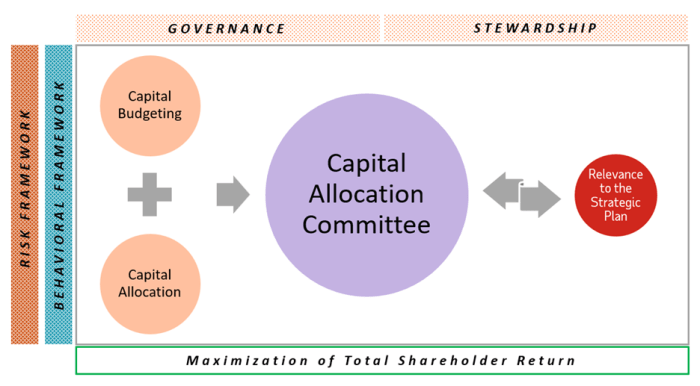
With Financial Capital Allocation at the forefront, this paragraph opens a window to an amazing start and intrigue, inviting readers to embark on a storytelling journey filled with unexpected twists and insights.
In today’s competitive business landscape, how companies strategically allocate their financial resources can make or break their success. This discussion dives deep into the art of Financial Capital Allocation, exploring its importance, strategies, and impact on overall growth.
Introduction to Financial Capital Allocation

Financial capital allocation is the process by which a business decides how to distribute and invest its resources in order to achieve its strategic objectives. It involves determining where to allocate funds within the organization, whether to invest in new projects, pay down debt, buy back shares, or distribute dividends to shareholders.
The Importance of Strategic Capital Allocation in Business
Effective capital allocation is crucial for the long-term success and sustainability of a business. By strategically allocating capital, companies can maximize their return on investment, minimize risks, and ensure that resources are used efficiently to drive growth and profitability.
Examples of How Companies Allocate Their Financial Capital
- Investing in Research and Development: Companies allocate funds to develop innovative products and services to maintain a competitive edge in the market.
- Acquisitions and Mergers: Some companies allocate capital to acquire or merge with other businesses to expand their market share and diversify their offerings.
- Capital Expenditures: Allocating funds towards capital expenditures such as building new facilities, upgrading technology, or purchasing equipment to support growth and efficiency.
- Debt Repayment: Companies may allocate capital to pay down debt in order to reduce interest expenses and improve their financial health.
Factors influencing Capital Allocation Decisions

When it comes to making capital allocation decisions, there are several key factors that play a crucial role in determining where resources should be allocated. These factors can range from risk assessment to the impact of capital structure on the overall decision-making process.
Role of Risk Assessment
Risk assessment is a critical factor in capital allocation decisions as it helps in evaluating the level of risk associated with each potential investment. By assessing the risks involved, companies can make informed decisions about where to allocate their capital. Factors such as market volatility, economic conditions, and industry trends are all taken into consideration during the risk assessment process.
It is essential to strike a balance between risk and return to ensure that capital is allocated in a way that maximizes profitability while minimizing potential losses.
Impact of Capital Structure
The capital structure of a company, which includes the mix of debt and equity used to finance operations, also plays a significant role in capital allocation decisions. A company’s capital structure can impact its cost of capital, financial flexibility, and overall risk profile. For instance, a company with a higher proportion of debt may have higher interest payments, which can impact its ability to invest in new opportunities.
On the other hand, a company with more equity financing may have a lower risk profile but may miss out on potential tax benefits associated with debt financing. Therefore, understanding the impact of capital structure is essential in making strategic capital allocation decisions.
Strategies for Efficient Capital Allocation
Efficient capital allocation is crucial for maximizing returns and ensuring sustainable growth for businesses. There are several strategies that companies can employ to allocate capital effectively, leading to improved financial performance and shareholder value.
Diversification
Diversification is a key strategy for efficient capital allocation, involving spreading investments across different asset classes, industries, or geographic regions. By diversifying their portfolio, companies can reduce risk exposure and enhance returns. For example, a company operating in the technology sector may allocate capital to invest in both established tech giants and emerging startups to diversify its revenue streams and mitigate industry-specific risks.
Capital Budgeting
Capital budgeting is another essential strategy for efficient capital allocation, focusing on evaluating and selecting the most profitable investment opportunities. Companies use various techniques such as Net Present Value (NPV), Internal Rate of Return (IRR), and Payback Period to assess the potential returns and risks associated with different projects. By prioritizing investments with high returns and favorable risk profiles, companies can optimize their capital allocation decisions.
Strategic Partnerships
Collaborating with strategic partners is a valuable strategy for efficient capital allocation, allowing companies to leverage resources, expertise, and market access without making significant capital investments. For instance, a company looking to expand into a new market may form a strategic partnership with a local distributor to minimize costs and accelerate market entry, optimizing its capital allocation while maximizing growth opportunities.
Acquisitions and Mergers
Acquisitions and mergers can be effective strategies for efficient capital allocation, enabling companies to consolidate resources, eliminate redundancies, and capitalize on synergies. Successful examples include Disney’s acquisition of Marvel Entertainment, which expanded its portfolio of iconic characters and franchises, driving revenue growth and creating value for shareholders through strategic capital allocation decisions.
Relationship between Capital Allocation and Capital Growth
Effective capital allocation plays a crucial role in driving overall capital growth for businesses. By strategically distributing resources across different projects, investments, and initiatives, companies can optimize their returns and fuel sustainable growth.
Impact of Capital Allocation on Capital Growth
Capital allocation directly impacts a company’s ability to grow and thrive in the long term. Allocating capital efficiently can maximize returns on investments, enhance profitability, and ultimately drive overall growth. On the other hand, poor capital allocation decisions can lead to wasted resources, missed opportunities, and hindered growth potential.
Aligning Capital Allocation with Growth Objectives
It is essential for companies to align their capital allocation decisions with their growth objectives. By prioritizing investments that support strategic goals and long-term growth plans, organizations can ensure that their resources are utilized effectively to drive sustainable expansion. This alignment helps in maximizing the impact of capital allocation on overall growth.
Examples of Effective Capital Allocation for Sustainable Growth
- Investing in research and development to drive innovation and product differentiation, leading to increased market share and revenue growth.
- Allocating resources to high-potential markets or business segments with strong growth prospects to capitalize on emerging opportunities.
- Acquiring complementary businesses or assets to expand market presence, diversify revenue streams, and achieve economies of scale.
In conclusion, mastering the art of Financial Capital Allocation is crucial for sustainable business growth. By aligning capital allocation with growth objectives and implementing efficient strategies, companies can pave the way for long-term success in a dynamic market environment.
Essential Questionnaire
How does risk assessment influence capital allocation decisions?
Risk assessment plays a crucial role in capital allocation by helping companies identify and mitigate potential risks associated with investment choices, ensuring a more secure allocation of financial resources.
What is the relationship between capital allocation and capital growth?
Capital allocation directly impacts overall capital growth as effective allocation strategies can lead to sustainable growth by maximizing returns on investments and aligning resources with growth objectives.





